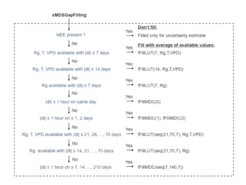Gap filling algorithm
Problem
The eddy covariance method delivers continuous data sets of mass and energy exchange between ecosystem and atmosphere. However, gaps due to unfavorable micro-meteorological conditions and due to instrument failure are inherent in the data stream. Thus a standardized filling of those gaps is necessary (gap-filling), e.g. to obtain daily, monthly or annually integrated balances.
Description
The gap filling of the eddy covariance and meteorological data are performed with methods similar to Falge et al. (2001) but also considering the co-variation of fluxes with meteorological variables and the temporal auto-correlation of the fluxes (Reichstein et al. 2005). In this algorithm, three different conditions are identified:
1) Only the data of direct interest is missing, but the meteorological data are available for radiation (Rg), air temperature (Tair), and vapour pressure deficit (VPD).
2) Also Tair or VPD are missing, but Rg is available.
3) Also Rg is missing.
Case 1): The missing value is replaced by the average value under similar meteorological conditions , i.e. with a look-up table (LUT), within a certain time window. Similar meteorological conditions are present when Rg does not deviate by more than 50 W m-2, Tair by 2.5°C, and VPD by 5.0 hPa. If no similar meteorological conditions are present within the starting time window of 7 days, the windows size is increased to 14 days.
Case 2): The same LUT approach is taken, but similar meteorological conditions can only be defined via Rg within a time window of 7 days.
Case 3): The missing value is replaced by the average value at the same time of the day (1 hour), i.e. by the mean diurnal course (MDC). In this case the window size starts is the same day, thus a linear interpolation of available data at adjacent hours.
If after these steps the values could not be filled, the procedure is repeated with increased window sizes until the value can be filled.
Long consequtive gaps, specifically 60 days or longer, are not gap-filled at all.
Uncertainty estimates
To estimate the flux uncertainties, the measurement value is marked as an artificial gap and filled with the same procedure described above. A description of the output variable naming can be found under the menu point "Output Format" above.
Flow diagram of the gap filling algorithm:

Reference
Reichstein M, Falge E, Baldocchi D et al. (2005) On the separation of net ecosystem exchange into assimilation and ecosystem respiration: review and improved algorithm. Global Change Biology, 11, 1424-1439.
